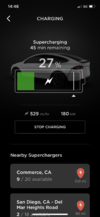Why not both? I suspect the original driver was a risk of increased powertrain warranty claims, but another ~18 months of data suggests that won’t be an issue. Wasn’t someone trying a class action as well?
I’d add in balancing potential future warranty liability against reducing the time older vehicles spend charging from a low SoC, in turn lowering the capital cost for building out new Superchargers. Tesla are exceptionally good at booking revenue now and deferring costs until later.
And another! Dec 2017 Model S 100D, capped to 108kW since August 2019 (~40K miles, 14,000kWh). Now at ~60K miles, 20,000kWh. Charging at v3 Supercharger at 150kW today from ~20%, tapering to 120kW at 35%, 90kW at 50%. Definitely a sharper drop off compared to when capped (perhaps heat related, although it’s only 57F out), but probably still faster charge overall from a low SoC.
View attachment 635314



